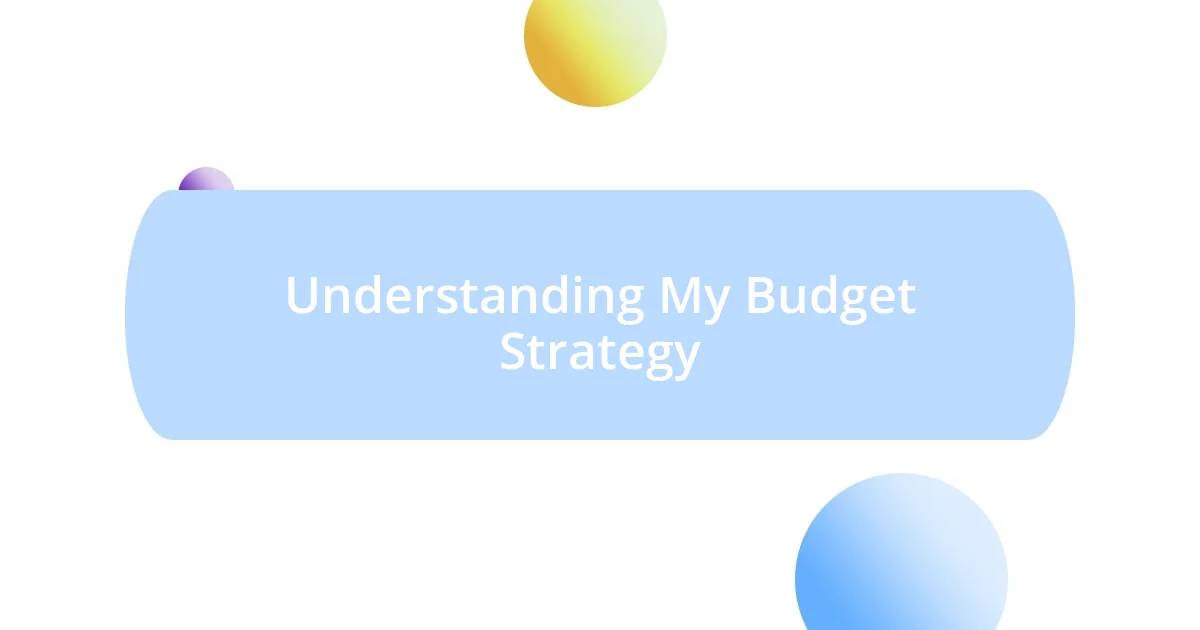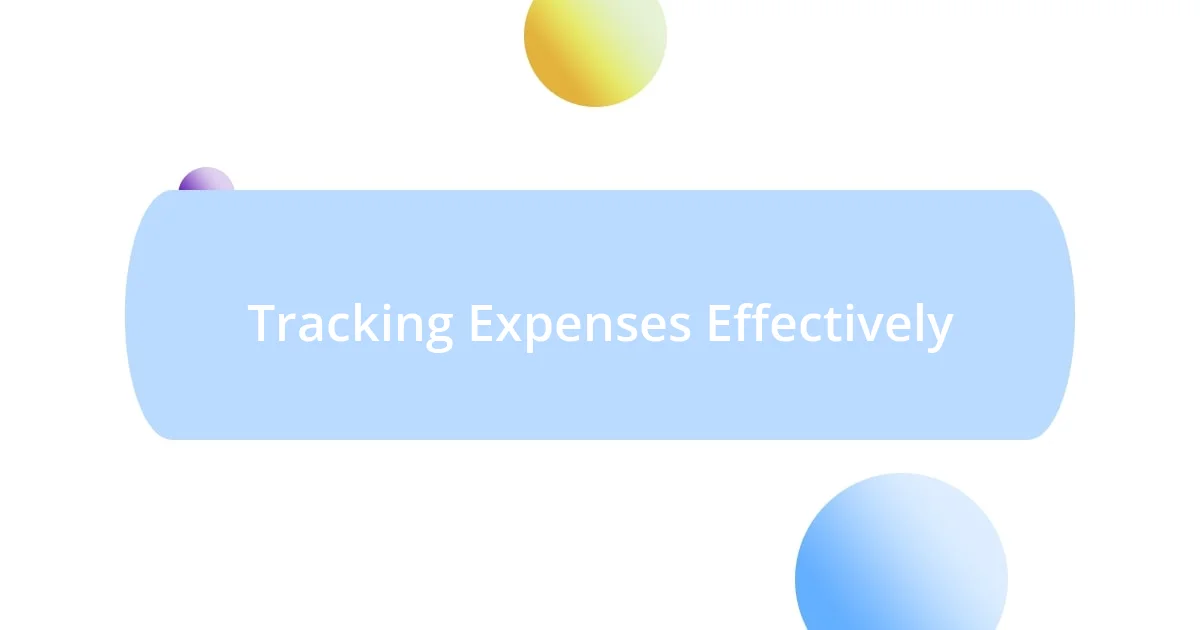Key takeaways:
- Effective budgeting involves understanding spending habits and prioritizing needs versus wants, as shown by the author’s personal experience.
- The 50/30/20 rule is a practical framework for financial management, promoting a balanced allocation of income among needs, wants, and savings.
- Regularly tracking expenses and adjusting budgets for evolving life circumstances are crucial to maintaining financial control and avoiding common pitfalls.

Understanding My Budget Strategy
When I first took the plunge into budgeting, I realized it wasn’t just about numbers; it was about understanding my spending habits and values. I remember staring at my bank statements, feeling overwhelmed but curious. It made me wonder, how can I align my finances with what truly matters to me?
Creating a budget strategy was, for me, a mix of trial and error. I used to categorize my expenses like groceries, entertainment, and savings, but I soon learned that it’s essential to prioritize my needs versus wants. For instance, when I had to decide between a concert ticket and a new pair of shoes, I paused and thought about which option would bring me more long-term happiness.
Over time, I found that reviewing my budget regularly was a game changer. It wasn’t just a set-it-and-forget-it approach; I adapted my strategy based on what I learned from my spending patterns. Have you ever felt that rush of satisfaction when you noticed where you could save more? It’s those little victories that fueled my passion for budgeting and keeping my expenses in check.

Essential Budgeting Techniques I Use
One essential technique I’ve found invaluable is the 50/30/20 rule. This simple yet effective framework involves allocating 50% of my income to needs (like rent and groceries), 30% to wants (think dining out or hobbies), and 20% to savings or debt repayment. Initially, I struggled with sticking to these boundaries, often allowing my desires to seep into my needs. However, I quickly learned that when I adhered to this structure, I felt a sense of control over my finances that I hadn’t experienced before.
- Track every penny: I log all my spending daily, which keeps me accountable.
- Use budgeting apps: I love how they simplify tracking, making it easier to visualize my goals.
- Automate savings: I set up automatic transfers to my savings account, which feels like paying myself first.
- Monthly financial check-ins: I schedule a time each month to review my progress and make adjustments; this habit has been crucial for my growth.
- Set realistic goals: I focus on achievable objectives, which helps me stay motivated—like saving for a weekend getaway instead of an extravagant vacation.

Tools That Simplified My Budgeting
When I began budgeting, I discovered several tools that truly simplified the process. One of my first loves was a spreadsheet. I created my own budgeting sheet, tailored to my needs, which allowed me to visualize my income and expenses easily. After seeing my financial flow laid out, it felt like a light bulb went off; I could track where my money was going and make informed decisions.
As I dove deeper, I embraced budgeting apps like Mint and YNAB (You Need A Budget). They brought that extra layer of ease that I didn’t know I needed. I remember the excitement of receiving instant notifications when I was nearing my spending limits. It kept me in check and making smarter choices. The real-time update feature helped me form better habits; I could see the impact of each coffee run or impulse purchase right away.
Lately, I’ve also incorporated digital envelope systems into my budgeting strategy. It’s a modern twist on a classic approach. I assigned different spending categories a digital “envelope” and allocated my funds accordingly. The thrill of seeing my envelopes fill up for savings while watching my discretionary spending dwindle was incredibly rewarding. This method has empowered me to prioritize what truly matters while still enjoying life.
| Tool | Description |
|---|---|
| Spreadsheets | Customizable, hands-on approach to tracking income and expenses. |
| Budgeting Apps (Mint, YNAB) | Real-time notifications and visuals to monitor spending and savings goals. |
| Digital Envelope Systems | Allocates funds for specific spending categories, enhancing financial control. |

Tracking Expenses Effectively
Tracking expenses effectively is a game-changer for anyone aiming to gain control over their finances. For me, logging every single transaction has not only made me accountable but has also deepened my understanding of my spending habits. I often find myself surprised at how small purchases, like that daily coffee run, can really add up. Have you ever looked back at your spending and thought, “Wow, I didn’t realize I spent so much on that”?
One tool I’ve found especially useful in this journey is the budgeting app, YNAB. I love how it prompts me to consider why I’m spending money. During one monthly review, I noticed a spike in my dining expenses and realized I was subconsciously using meals out as a reward for a stressful week. This insight allowed me to redefine my relationship with food and spending, pushing me to cook more at home while still enjoying the occasional treat. How about you—do you recognize patterns in your spending that could use a little love?
Ultimately, regular check-ins of my financial progress have been pivotal. Setting aside time each month to sit down and evaluate my budget allows me to celebrate my wins and address any areas needing improvement. I remember one month where I managed to save significantly more than I expected. The joy of seeing those extra dollars emerge felt fantastic! It’s like a little high-five from my future self, wouldn’t you agree?

Avoiding Common Budgeting Pitfalls
One pitfall I’ve encountered in budgeting is underestimating irregular expenses. I remember a month when my car needed repairs, and suddenly my budget felt tight. It was a wake-up call that life throws curveballs, and failing to plan for them can derail even the best budgeting strategies. Have you ever found yourself in a similar situation, realizing there’s more to budgeting than just income and regular bills?
Another common mistake is failing to adjust the budget as life changes. I used to cling to my initial budget like it was set in stone, thinking it was the best approach. But, when I started a new job with different travel expenses, I had to revisit and tweak my budget. This flexibility not only helped me adapt but also kept me motivated, knowing my budget could evolve alongside my circumstances.
Lastly, I’ve learned that ignoring small, repeated expenditures can be detrimental. There was a time I casually spent on subscriptions, thinking they were negligible. But when I totaled those costs, I was shocked to find they made a significant dent in my savings potential. It’s essential to keep an eye on these sneaky expenses. Have you checked your subscriptions lately? You might be surprised at what you discover.














